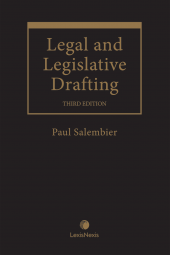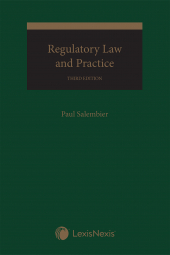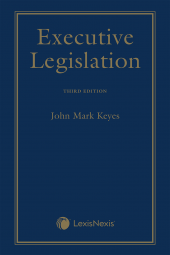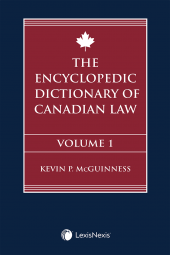Legal and Legislative Drafting, 3rd Edition
One Year Subscription Only Terms
Subscribers receive the product(s) listed on the Order Form and any Updates made available during the annual subscription period. Shipping and handling fees are not included in the annual price.
Subscribers are advised of the number of Updates that were made to the particular publication the prior year. The number of Updates may vary due to developments in the law and other publishing issues, but subscribers may use this as a rough estimate of future shipments. Subscribers may call Customer Support at 800-833-9844 for additional information.
Subscribers may cancel this subscription by: calling Customer Support at 800-833-9844; emailing customer.support@lexisnexis.com; or returning the invoice marked 'CANCEL'.
If subscribers cancel within 30 days after the product is ordered or received and return the product at their expense, then they will receive a full credit of the price for the annual subscription.
If subscribers cancel between 31 and 60 days after the invoice date and return the product at their expense, then they will receive a 5/6th credit of the price for the annual subscription. No credit will be given for cancellations more than 60 days after the invoice date. To receive any credit, subscriber must return all product(s) shipped during the year at their expense within the applicable cancellation period listed above.
Détails des produits
Drafting complex legal and legislative documents can be challenging. From the organization of complex ideas to ensuring clear and unambiguous language, legal and legislative drafting is a demanding task. Mistakes can be costly – even catastrophic – for lawyers who face malpractice claims if drafting errors cost their clients money. Those charged with drafting legislative or legal documents need a solution to help them navigate through these challenges.
Legal and Legislative Drafting, 3rd Edition helps legislative drafters and private sector lawyers write concise and precise legal documents by providing them with:
- Practical advice – The book's step-by-step approach leaves theory-driven publications far behind
- Expert guidance – Over 1,000 examples are covered to help illustrate how provisions evolve through the application of various drafting techniques
- Best practices – Helps drafters deal with other key parties in the process and increase their efficiency
- Invaluable tools – Allow drafters to choose the right words in the appropriate context to convey the document's intended meaning
What’s New in This Edition
- Many new examples, additions and improvements since the previous edition published in 2018
- Three brand new chapters, covering:
- The drafting of legislation in second or multiple languages (Chapter 14)
- A discussion of the potential for artificial intelligence to improve and expedite, if not supplant, the work of legislative drafters (Chapter 15)
- The practices and pitfalls of co-developing legislation with stakeholders (Chapter 17)
- Expansion of best practices (Chapter 18), covering:
- The training of legislative drafters with analysis of the inefficiency and inadequacy of current methods of inaugurating newcomers to the field
Who Should Read This Book
- Legislative drafters – who need to understand the principles and practices of legislative drafting to master their skills
- Private sector lawyers – who engage in drafting complex contracts, leases, and other legal documents
- International lawyers or legislative drafters – who require an international perspective on legislative drafting in negotiating or analyzing treaties
- Law professors and students – who seek an accessible solution for legal writing courses
Table des matières
Preface
Chapter 1: The Essence of Drafting
Chapter 2: Composing a Legislative Sentence
Chapter 3: Choosing the Right Words
Chapter 4: Gender-Neutral Drafting
Chapter 5: Reducing Complexity
Chapter 6: Definitions and Other Interpretive Provisions
Chapter 7: Problematic Provisions
Chapter 8: Transitional and Savings Provisions
Chapter 9: Structuring Legislation and Contracts
Chapter 10: Amendments
Chapter 11: Logical Challenges
Chapter 12: Using an Interpretation Act
Chapter 13: Plain Language Drafting
Chapter 14: Drafting in a Multilingual Jurisdiction
Chapter 15: Computer-Assisted Drafting
Chapter 16: Drafting to Limit Corruption
Chapter 17: Co-Development of Legislation
Chapter 18: Best Practices
Table of Cases
Index
 Lexis Nexis
Lexis Nexis 


